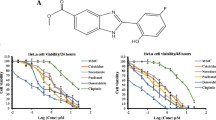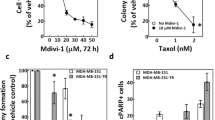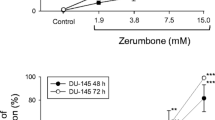Abstract
Arsenic trioxide (As2O3) has potential anti-cancer activity against a wide range of carcinomas via apoptosis induction or oncoprotein degradation. The mechanisms involved are not fully elucidated. Here, we demonstrated that As2O3 induced-apoptosis in HeLa and MCF-7 cancer cells was in part triggered by tubulin polymerization. High expression of JWA promoted tubulin polymerization and increased the sensitivity of the cancer cells to As2O3. The activation of the p38 MAPK (mitogen-activated protein kinases) signaling pathway was found to contribute to JWA-promoted tubulin polymerization. Our results suggest that JWA may serve as an effective enhancer of microtubule-targeted As2O3 anti-cancer therapy.












Similar content being viewed by others
References
Waxman S, Anderson KC (2001) History of the development of arsenic derivatives in cancer therapy. Oncologist 6(Suppl 2):3–10
Yu J, Qian H, Li Y, Wang Y, Zhang X, Liang X et al (2007) Therapeutic effect of arsenic trioxide (As2O3) on cervical cancer in vitro and in vivo through apoptosis induction. Cancer Biol Ther 6:580–586
Ling YH, Jiang JD, Holland JF, Perez-Soler R (2002) Arsenic trioxide produces polymerization of microtubules and mitotic arrest before apoptosis in human tumor cell lines. Mol Pharmacol 62:529–538
Jordan MA, Wilson L (2004) Microtubules as a target for anticancer drugs. Nat Rev Cancer 4:253–265
Li YM, Broome JD (1999) Arsenic targets tubulins to induce apoptosis in myeloid leukemia cells. Cancer Res 59:776–780
Zhou JW, Di YP, Zhao YH, Wu R (1999) A novel cytoskeleton associate gene-cloning, identification, sequencing, regulation of expression and tissue distribution of JWA (in Chinese). In: Ye XS, Shen BF, Tang XF (eds) Investigation on cell modulation: signal transduction, apoptosis and gene expression. Military Medical Sciences Press, Beijing, pp 110–119
Chen H, Bai J, Ye J, Liu Z, Chen R, Mao W et al (2007) JWA as a functional molecule to regulate cancer cells migration via MAPK cascades and F-actin cytoskeleton. Cell Signal 19:1315–1327
Huang S, Shen Q, Mao WG, Li AP, Ye J, Liu QZ et al (2006) JWA, a novel signaling molecule, involved in all-trans retinoic acid induced differentiation of HL-60 cells. J Biomed Sci 13:357–371
Huang S, Shen Q, Mao WG, Li AP, Ye J, Liu QZ et al (2006) JWA, a novel signaling molecule, involved in the induction of differentiation of human myeloid leukemia cells. Biochem Biophys Res Commun 341:440–450
Zhou J, Ye J, Zhao X, Li A, Zhou J (2008) JWA is required for arsenic trioxide induced apoptosis in HeLa and MCF-7 cells via reactive oxygen species and mitochondria linked signal pathway. Toxicol Appl Pharmacol 230:33–40
Johnson GL, Lapadat R (2002) Mitogen-activated protein kinase pathways mediated by ERK, JNK, and p38 protein kinases. Science 298:1911–1912
Hu JY, Chu ZG, Han J, Dang YM, Yan H, Zhang Q, et al (2010) The p38/MAPK pathway regulates microtubule polymerization through phosphorylation of MAP4 and Op18 in hypoxic cells. Cell Mol Life Sci 67:321–333
Bogatcheva NV, Adyshev D, Mambetsariev B, Moldobaeva N, Verin AD (2007) Involvement of microtubules, p38, and Rho kinases pathway in 2-methoxyestradiol-induced lung vascular barrier dysfunction. Am J Physiol Lung Cell Mol Physiol 292:L487–L499
Minotti AM, Barlow SB, Cabral F (1991) Resistance to antimitotic drugs in Chinese hamster ovary cells correlates with changes in the level of polymerized tubulin. J Biol Chem 266:3987–3994
Jing Y, Dai J, Chalmers-Redman RM, Tatton WG, Waxman S (1999) Arsenic trioxide selectively induces acute promyelocytic leukemia cell apoptosis via a hydrogen peroxide-dependent pathway. Blood 94:2102–2111
Jia Z, Vadnais J, Lu ML, Noel J, Nabi IR (2006) Rho/ROCK-dependent pseudopodial protrusion and cellular blebbing are regulated by p38 MAPK in tumour cells exhibiting autocrine c-Met activation. Biol Cell 98:337–351
Shtil AA, Mandlekar S, Yu R, Walter RJ, Hagen K, Tan TH et al (1999) Differential regulation of mitogen-activated protein kinases by microtubule-binding agents in human breast cancer cells. Oncogene 18:377–384
Birukova AA, Birukov KG, Gorshkov B, Liu F, Garcia JG, Verin AD (2005) MAP kinases in lung endothelial permeability induced by microtubule disassembly. Am J Physiol Lung Cell Mol Physiol 289:L75–L84
Lane JD, Allan VJ, Woodman PG (2005) Active relocation of chromatin and endoplasmic reticulum into blebs in late apoptotic cells. J Cell Sci 118:4059–4071
Moss DK, Betin VM, Malesinski SD, Lane JD (2006) A novel role for microtubules in apoptotic chromatin dynamics and cellular fragmentation. J Cell Sci 119:2362–2374
Taylor BF, McNeely SC, Miller HL, States JC (2008) Arsenite-induced mitotic death involves stress response and is independent of tubulin polymerization. Toxicol Appl Pharmacol 230:235–246
Chen J, Gu HY, Lu N, Yang Y, Liu W, Qi Q et al (2008) Microtubule depolymerization and phosphorylation of c-Jun N-terminal kinase-1 and p38 were involved in gambogic acid induced cell cycle arrest and apoptosis in human breast carcinoma MCF-7 cells. Life Sci 83:103–109
Zhu T, Chen R, Li A, Liu J, Gu D, Liu Q et al (2006) JWA as a novel molecule involved in oxidative stress-associated signal pathway in myelogenous leukemia cells. J Toxicol Environ Health A 69:1399–1411
Zhu T, Chen R, Li AP, Liu J, Liu QZ, Chang HC et al (2005) Regulation of a novel cell differentiation-associated gene, JWA during oxidative damage in K562 and MCF-7 cells. J Biomed Sci 12:219–227
Vogl T, Ludwig S, Goebeler M, Strey A, Thorey IS, Reichelt R et al (2004) MRP8 and MRP14 control microtubule reorganization during transendothelial migration of phagocytes. Blood 104:4260–4268
Pettit EJ, Fay FS (1998) Cytosolic free calcium and the cytoskeleton in the control of leukocyte chemotaxis. Physiol Rev 78:949–967
Nick JA, Avdi NJ, Young SK, Lehman LA, McDonald PP, Frasch SC et al (1999) Selective activation and functional significance of p38alpha mitogen-activated protein kinase in lipopolysaccharide-stimulated neutrophils. J Clin Investig 103:851–858
Yang Y, Zhu X, Chen Y, Wang X, Chen R (2007) p38 and JNK MAPK, but not ERK1/2 MAPK, play important role in colchicine-induced cortical neurons apoptosis. Eur J Pharmacol 576:26–33
Kang YH, Lee SJ (2008) Role of p38 MAPK and JNK in enhanced cervical cancer cell killing by the combination of arsenic trioxide and ionizing radiation. Oncol Rep 20:637–643
Adrain C, Duriez PJ, Brumatti G, Delivani P, Martin SJ (2006) The cytotoxic lymphocyte protease, granzyme B, targets the cytoskeleton and perturbs microtubule polymerization dynamics. J Biol Chem 281:8118–8125
Cassimeris L (2002) The oncoprotein 18/stathmin family of microtubule destabilizers. Curr Opin Cell Biol 14:18–24
McNally FJ, Vale RD (1993) Identification of katanin, an ATPase that severs and disassembles stable microtubules. Cell 75:419–429
Hunter AW, Caplow M, Coy DL, Hancock WO, Diez S, Wordeman L et al (2003) The kinesin-related protein MCAK is a microtubule depolymerase that forms an ATP-hydrolyzing complex at microtubule ends. Mol Cell 11:445–457
Walczak CE, Mitchison TJ, Desai A (1996) XKCM1: a xenopus kinesin-related protein that regulates microtubule dynamics during mitotic spindle assembly. Cell 84:37–47
Kligerman AD, Tennant AH (2007) Insights into the carcinogenic mode of action of arsenic. Toxicol Appl Pharmacol 222:281–288
Acknowledgments
We are grateful to Dr. Jiahuai Han of the Scripps Research Institute, La Jolla, CA, USA and Dr. Gang Li of the University of British Columbia, Canada for providing pcDNA3-MKK6b and FLAG-JWA, respectively. This study was supported in part by the project funded by the Priority Academic Program Development (PAPD) of Jiangsu Higher Education Institutions and the National Natural Science Foundation of China (30930080 to JZ; 30771828 to JY).
Author information
Authors and Affiliations
Corresponding author
Rights and permissions
About this article
Cite this article
Shen, L., Xu, W., Li, A. et al. JWA enhances As2O3-induced tubulin polymerization and apoptosis via p38 in HeLa and MCF-7 cells. Apoptosis 16, 1177–1193 (2011). https://doi.org/10.1007/s10495-011-0637-6
Published:
Issue Date:
DOI: https://doi.org/10.1007/s10495-011-0637-6




